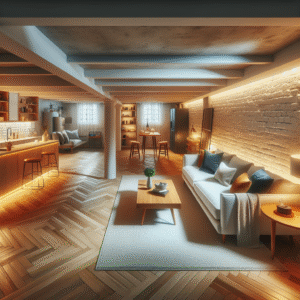Choosing the right flooring for your home is a major decision that can significantly affect the overall look, comfort, and value of your space. With so many materials, designs, and options available, selecting the perfect flooring can be overwhelming. Whether you’re renovating a single room or your entire home, it’s important to choose flooring that fits your lifestyle, aesthetic, and budget.
In this comprehensive guide, we’ll walk you through 10 essential tips for choosing the right flooring for your home. From considering durability and comfort to evaluating maintenance needs, we’ll help you make an informed decision that balances style with practicality.
1. Consider the Room’s Function and Traffic
The first step in choosing the right flooring is to think about the room’s function and the amount of foot traffic it receives. Different rooms serve different purposes, and the flooring you choose should reflect how the space is used.
High-Traffic Areas:
Rooms like entryways, hallways, and kitchens often experience heavy foot traffic. For these areas, it’s important to choose durable flooring that can withstand wear and tear while still looking great.
- Tile: Ceramic or porcelain tile is incredibly durable, scratch-resistant, and easy to clean, making it ideal for high-traffic areas like kitchens and entryways.
- Vinyl: Luxury vinyl planks or tiles are also highly durable and water-resistant, making them a popular choice for busy spaces.
- Laminate: Modern laminate flooring is designed to mimic the look of hardwood while offering better scratch and dent resistance, perfect for high-traffic areas.
Low-Traffic Areas:
In spaces like bedrooms and living rooms, comfort and aesthetics often take precedence over durability. These areas typically see less foot traffic, so you can opt for softer, more luxurious flooring materials.
- Carpet: Carpet adds warmth, comfort, and sound insulation, making it ideal for bedrooms and living spaces.
- Hardwood: Hardwood floors are a timeless choice for living rooms and bedrooms, providing natural beauty and a sense of luxury.
By considering the amount of traffic a room will receive, you can choose flooring that meets both the practical and aesthetic needs of the space.
2. Prioritize Durability for Long-Term Value
When selecting flooring, think long-term. The flooring you choose should stand up to the daily wear and tear of your household while maintaining its appearance. Durability is especially important in high-traffic areas, homes with pets or children, and spaces prone to moisture.
Highly Durable Flooring:
- Porcelain Tile: Porcelain tile is extremely hard and durable, making it resistant to scratches, stains, and water damage. It’s perfect for kitchens, bathrooms, and mudrooms.
- Engineered Hardwood: Engineered hardwood is more resistant to moisture and temperature fluctuations than solid hardwood, making it a great choice for high-traffic areas and basements.
- Luxury Vinyl: Luxury vinyl flooring is not only durable and water-resistant but also scratch-resistant, making it ideal for homes with pets and children.
Less Durable Flooring:
- Softwood: While softwoods like pine offer a warm, natural aesthetic, they’re more prone to dents and scratches than hardwoods. Softwood may not be ideal for high-traffic areas.
- Low-End Laminate: While laminate is durable, lower-quality laminate can show signs of wear over time. Invest in high-quality laminate to ensure long-lasting durability.
Choosing a durable flooring material is a smart investment that will save you money on repairs and replacements in the long run.
3. Factor in Maintenance and Cleaning
Different types of flooring require varying levels of maintenance and cleaning. If you have a busy household or prefer low-maintenance options, it’s important to choose flooring that fits your lifestyle.
Low-Maintenance Flooring:
- Tile: Tile is one of the easiest flooring types to maintain. It resists stains and water, and regular sweeping and mopping will keep it looking clean.
- Vinyl: Vinyl flooring requires minimal upkeep. It’s resistant to water and scratches, making it easy to clean with just a mop or broom.
- Laminate: Laminate flooring is also easy to maintain. Sweeping or vacuuming regularly will help avoid dust buildup, and occasional mopping with a damp cloth will keep it looking fresh.
Higher-Maintenance Flooring:
- Hardwood: Hardwood floors require regular cleaning to prevent scratches and water damage. You’ll need to sweep frequently, and refinishing may be necessary every few years to maintain their appearance.
- Carpet: Carpet requires regular vacuuming and professional cleaning to remove dirt and allergens. Stains can be difficult to remove, making carpet less suitable for homes with pets or young children.
If you’re looking for a flooring option that requires minimal upkeep, consider vinyl, tile, or laminate. For those willing to invest time in maintenance, hardwood or carpet can add a luxurious touch.
4. Understand the Pros and Cons of Each Material
Before making a final decision, it’s important to understand the strengths and weaknesses of each flooring material. Each material offers different benefits depending on your needs and the room in which it will be installed.
Hardwood:
- Pros: Hardwood is durable, timeless, and adds value to your home. It can be refinished multiple times, making it a long-lasting choice.
- Cons: It’s susceptible to moisture damage, scratches, and dents, and requires regular maintenance to keep it looking its best.
Tile:
- Pros: Tile is highly durable, water-resistant, and easy to clean. It comes in a wide variety of styles and colors, making it versatile for any room.
- Cons: Tile can be hard and cold underfoot, which may make it less comfortable in living spaces or bedrooms. Grout lines may require periodic cleaning.
Vinyl:
- Pros: Vinyl is affordable, water-resistant, and durable. It’s available in a wide range of styles, including options that mimic wood or stone.
- Cons: Vinyl may not have the same long-term value as hardwood or tile and can be less eco-friendly.
Carpet:
- Pros: Carpet adds warmth, comfort, and sound insulation. It’s ideal for bedrooms and living rooms where you want a cozy, soft surface.
- Cons: Carpet stains easily and requires regular cleaning. It’s not ideal for moisture-prone areas like bathrooms or kitchens.
Laminate:
- Pros: Laminate is affordable, durable, and easy to install. It’s available in a variety of styles that mimic hardwood or tile.
- Cons: Laminate can be prone to moisture damage and doesn’t have the same longevity as hardwood or tile.
Understanding the pros and cons of each material will help you choose the one that best fits your needs, budget, and aesthetic preferences.
5. Consider the Room’s Aesthetic and Design
Your flooring choice will have a significant impact on the overall look and feel of your home. The material, color, and finish you choose should complement the room’s design and your personal style.
Light vs. Dark Flooring:
- Light Flooring: Light-colored floors, such as pale wood or white tile, can make a room feel larger, brighter, and more open. Light flooring works well in modern, minimalist, or coastal-style homes.
- Dark Flooring: Dark-colored floors, such as walnut or dark oak, create a sense of richness and warmth. They are ideal for traditional or contemporary interiors that feature bold color contrasts.
Texture and Pattern:
Incorporating texture or pattern into your flooring can add depth and visual interest to a room. For example, textured wood floors or patterned tiles can become focal points in otherwise neutral spaces.
Continuity Between Rooms:
If you’re renovating multiple rooms, consider using the same flooring material throughout to create a cohesive look. Using different flooring materials in connected spaces can create a jarring effect, so aim for continuity or complementary designs.
6. Keep Comfort in Mind
While aesthetics and durability are important, comfort is also a key factor to consider, especially in rooms where you spend a lot of time standing, such as the kitchen or bathroom.
Comfortable Flooring Options:
- Cork: Cork flooring is soft and provides natural cushioning underfoot, making it a comfortable option for kitchens and playrooms.
- Carpet: Carpet adds warmth and softness, making it a cozy option for bedrooms or family rooms.
- Vinyl: Vinyl flooring offers some give underfoot, making it more comfortable to stand on for long periods than harder materials like tile or stone.
Harder Flooring Options:
- Tile and Stone: While tile and stone are highly durable, they can be cold and hard underfoot. Consider using area rugs or mats in areas where you stand frequently, such as in front of the sink or stove.
By keeping comfort in mind, you can choose a flooring material that not only looks great but feels good to walk on every day.
7. Evaluate the Room’s Moisture Levels
In moisture-prone areas like bathrooms, kitchens, and basements, it’s essential to choose flooring that can handle water exposure without damage. Moisture-resistant materials will prevent issues like warping, mold, and mildew.
Best Flooring for Moisture-Prone Areas:
- Tile: Ceramic or porcelain tile is ideal for high-moisture areas because it is water-resistant and easy to clean.
- Vinyl: Luxury vinyl is also waterproof, making it a great option for bathrooms, kitchens, and basements.
- Engineered Hardwood: While solid hardwood can warp in humid environments, engineered hardwood offers better resistance to moisture and is a good option for basements or kitchens.
Flooring to Avoid in High-Moisture Areas:
- Solid Hardwood: Solid hardwood is not recommended for areas with high moisture levels, as it can warp, swell, and become damaged over time.
- Carpet: Carpet can absorb moisture, leading to mold or mildew growth in damp areas like basements or bathrooms.
By choosing moisture-resistant flooring for areas prone to water exposure, you can protect your investment and prevent costly repairs.
8. Think About Your Home’s Climate
The climate where you live can have an impact on the performance of certain flooring materials. For example, homes in humid or coastal areas may require moisture-resistant flooring, while homes in colder climates may benefit from materials that provide warmth.
For Humid or Coastal Climates:
- Tile: Tile is highly resistant to humidity and moisture, making it a great choice for homes in coastal or humid regions.
- Vinyl: Vinyl is also resistant to moisture and won’t warp or swell in humid climates.
For Cold Climates:
- Carpet: Carpet provides insulation and warmth, making it ideal for homes in colder climates.
- Hardwood: Hardwood can be a great choice in colder climates, but it’s important to maintain proper humidity levels to prevent warping or shrinking.
Choosing flooring that suits your climate will ensure that it performs well over time and provides comfort throughout the seasons.
9. Set a Realistic Budget
Flooring can range in cost depending on the material, quality, and installation requirements. It’s important to set a realistic budget that takes into account both the initial cost of the flooring and any long-term maintenance or repair needs.
Budget-Friendly Options:
- Vinyl: Vinyl flooring is one of the most affordable options and offers good durability for the price.
- Laminate: Laminate is also budget-friendly and provides the look of hardwood or tile without the high cost.
Higher-End Options:
- Hardwood: While hardwood is more expensive upfront, it adds value to your home and can last for decades with proper care.
- Tile: Porcelain or natural stone tiles are more expensive but offer long-lasting durability and timeless style.
When setting your budget, consider both the cost of materials and installation. Some flooring types, such as tile or hardwood, may require professional installation, which can increase the overall cost.
10. Consult a Professional
Finally, if you’re unsure which flooring option is best for your home, don’t hesitate to consult a professional. Flooring experts can help you navigate the wide range of materials available, provide advice based on your specific needs, and ensure that your flooring is installed correctly.
When to Hire a Professional:
- Installation: For materials like tile, hardwood, or engineered hardwood, professional installation is often recommended to ensure a quality finish.
- Customization: If you’re considering custom patterns, designs, or materials, a professional can help bring your vision to life.
- Complex Renovations: If your renovation involves multiple rooms or structural changes, a professional can provide guidance on continuity, transitions, and material choices.
By consulting a professional, you can ensure that your flooring choice is not only beautiful but functional and long-lasting.
FAQ
1. How do I choose the right flooring for my home?
Consider factors such as the room’s function, traffic, climate, moisture levels, and your personal aesthetic preferences. Choose a flooring material that balances durability, comfort, and style.
2. What flooring is best for high-traffic areas?
For high-traffic areas like kitchens, entryways, and hallways, durable materials like tile, vinyl, and laminate are excellent choices. These materials are resistant to scratches, stains, and moisture.
3. Can I install hardwood flooring in a bathroom?
Solid hardwood is not recommended for bathrooms due to moisture concerns. However, engineered hardwood or moisture-resistant flooring options like tile or vinyl are better suited for bathroom environments.
4. How often should carpet be replaced?
Carpet typically lasts 5-15 years, depending on the quality and the amount of foot traffic it receives. Regular cleaning and maintenance can help extend its lifespan.
5. What is the most budget-friendly flooring option?
Vinyl and laminate are two of the most budget-friendly flooring options. Both materials offer good durability and come in a variety of styles that mimic more expensive materials like hardwood or tile.
Conclusion
Choosing the right flooring for your home involves balancing aesthetics, durability, comfort, and maintenance. By considering the specific needs of each room, the amount of traffic it receives, and your overall design preferences, you can select flooring that enhances both the functionality and beauty of your space. Whether you prefer the timeless elegance of hardwood, the durability of tile, or the affordability of vinyl, following these 10 essential tips will help you make an informed decision that you’ll be happy with for years to come.








